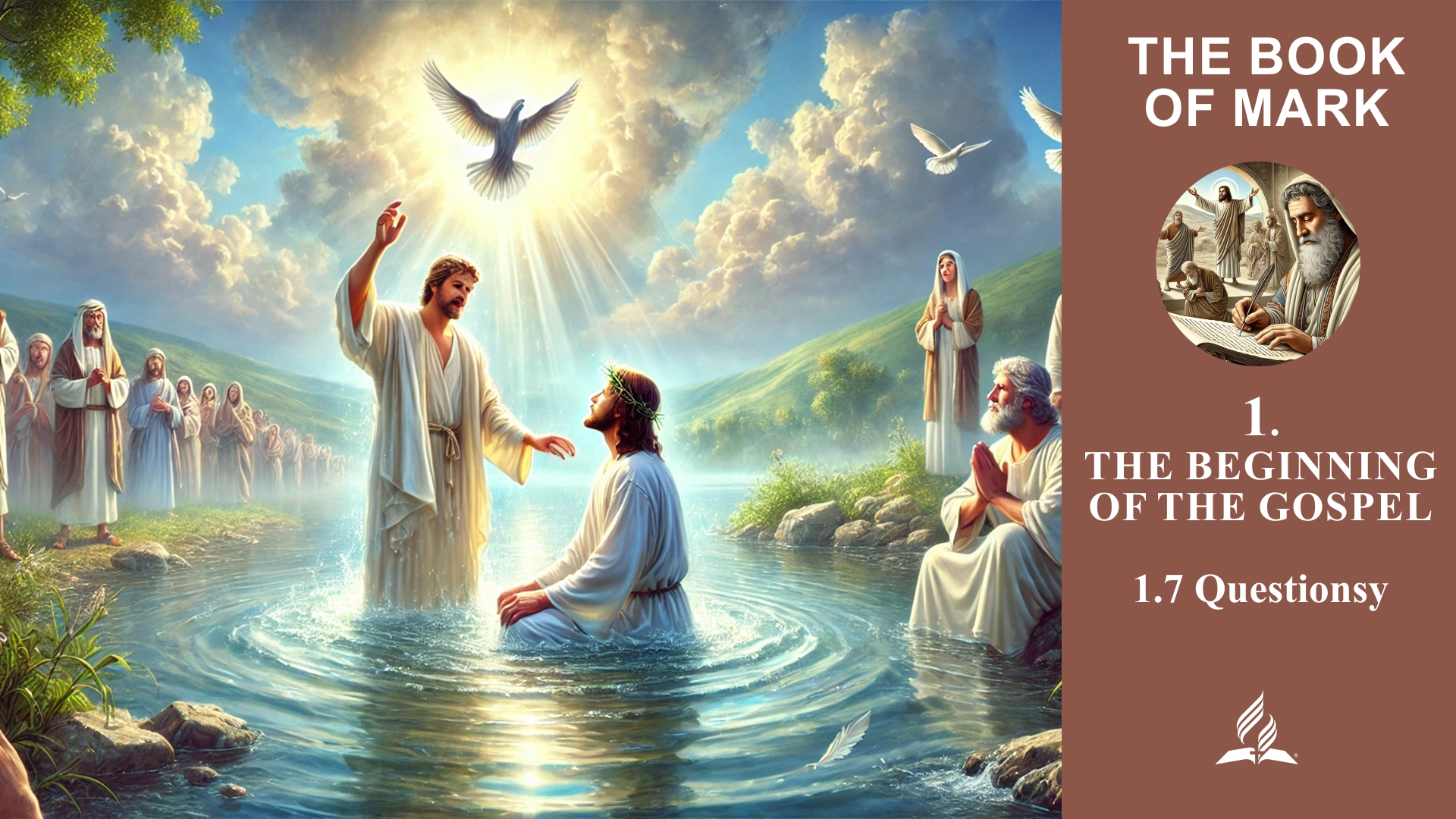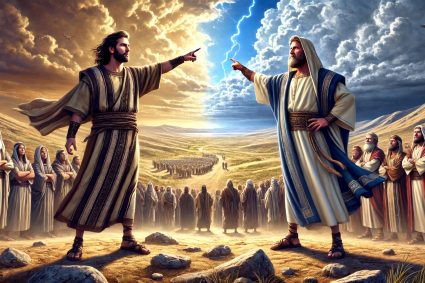


1.Compare John the Baptist and Jesus in Mark 1:1-13 and contrast them. What special lessons do you draw from the way they are depicted?
In the first 13 verses of the Gospel of Mark, John the Baptist and Jesus are introduced and depicted in a special way. Here are some key points that highlight their differences and similarities:
John the Baptist:
-
Introduction:
-
Verses 2-4: John the Baptist is introduced as the messenger who is to prepare the way for the Lord. His role is supported by quotes from Isaiah and Malachi, emphasizing his prophetic significance.
-
-
Location and Activity:
-
Verse 4: John preaches in the wilderness and baptizes people in the Jordan for the forgiveness of sins. His ministry is aimed at calling people to repentance and preparation for the coming Messiah.
-
-
Appearance and Lifestyle:
-
Verse 6: John wears clothing made of camel’s hair and a leather belt, reminiscent of the prophet Elijah. He lives on locusts and wild honey, highlighting his ascetic lifestyle.
-
-
Message:
-
Verses 7-8: John proclaims that someone mightier than he is coming, who will baptize with the Holy Spirit. He views himself as insignificant compared to the one who is to come.
-
Jesus Christ:
-
Introduction:
-
Verse 1: Jesus is introduced as the Christ, the Son of God. This statement highlights his divine nature and central role in God’s plan of salvation.
-
-
Baptism and Confirmation:
-
Verses 9-11: Jesus is baptized by John in the Jordan. As he comes out of the water, the heavens open, the Holy Spirit descends like a dove on him, and a voice from heaven declares, “You are my beloved Son; with you I am well pleased.” This shows divine confirmation and anointing for his ministry.
-
-
Temptation:
-
Verses 12-13: After his baptism, Jesus is driven by the Holy Spirit into the wilderness, where he is tempted by Satan for 40 days. He is among wild animals, and angels serve him. This emphasizes his human nature and his willingness to face challenges and temptations.
-
Special Lessons from Their Depiction:
-
Preparation and Fulfillment:
-
John the Baptist prepares the way for Jesus, who is the fulfillment of Old Testament prophecies. John is the forerunner calling people to repentance, while Jesus is the promised Messiah bringing the Kingdom of God.
-
-
Humility and Greatness:
-
John shows great humility by acknowledging his role as secondary and serving compared to Jesus. Jesus, in turn, is depicted as the mighty Savior, whose ministry is confirmed by God himself.
-
-
Divine Confirmation:
-
Jesus receives direct confirmation of his divine sonship and mission at his baptism. This shows that his ministry is divinely anointed and supported, highlighting his supernatural nature and mission.
-
-
Humanity and Divinity:
-
While John stands out for his ascetic lifestyle and prophetic role, Jesus is depicted both in his humanity (through baptism and temptation) and his divinity (through heavenly confirmation). This shows Jesus’ unique nature as both God and man.
-
In summary, the comparison of John the Baptist and Jesus in Mark 1:1-13 shows how both figures play important roles in God’s plan of salvation but have different functions and significance. John prepares the way and calls for repentance, while Jesus is the promised Messiah who brings the Kingdom of God and receives divine confirmation. These depictions teach us the importance of humility, preparation for God’s work, and the recognition of Jesus’ divine mission.

2.Reflect on the significance of baptism. Read Romans 6:1-4 and John 3:1-8 and compare these verses with Jesus’ baptism in Mark 1:9-13. What parallels and contrasts do you see? How does this help you better understand the significance of baptism?
Mark 1:9-13: The Baptism of Jesus In Mark 1:9-13, Jesus’ baptism in the Jordan by John the Baptist is described. After the baptism, the heavens open, the Holy Spirit descends like a dove upon Jesus, and a voice from heaven says, “You are my beloved Son; with you I am well pleased.” These events mark the beginning of Jesus’ public ministry and confirm his identity as the Son of God.
Romans 6:1-4: Baptism as a Symbol of Death and Resurrection In Romans 6:1-4, Paul explains baptism as a symbol of the death and resurrection of Jesus Christ. He emphasizes that through baptism, believers are baptized into Jesus’ death so that they may also be raised to new life like Christ. Baptism symbolizes the turning away from an old life of sin and the beginning of a new life in Christ.
John 3:1-8: The Necessity of Being Born Again In John 3:1-8, Jesus speaks with Nicodemus about the necessity of being born again through water and the Spirit to enter the Kingdom of God. Jesus emphasizes that one must be “born again,” which means a spiritual renewal and transformation. This rebirth is essential for salvation and new life in Christ.
Parallels and Contrasts:
Parallels:
-
New Identity and Beginning:
-
Mark 1:9-13: Jesus’ baptism marks the beginning of his public ministry and confirms his divine identity.
-
Romans 6:1-4: Baptism symbolizes the beginning of a new life for believers, as they die and rise with Christ.
-
John 3:1-8: Being born again through water and the Spirit marks the beginning of a new spiritual life and entry into the Kingdom of God.
-
-
Confirmation by the Holy Spirit:
-
Mark 1:10: The Holy Spirit descends like a dove upon Jesus.
-
John 3:5-6: Jesus speaks of being born of water and the Spirit, emphasizing the necessity of spiritual renewal by the Holy Spirit.
-
-
Transformation and New Life:
-
Romans 6:4: Baptism leads to a new life, free from the power of sin.
-
John 3:3: Being born again is a spiritual transformation necessary for salvation.
-
Contrasts:
-
Purpose of Baptism:
-
Mark 1:9-11: Jesus’ baptism serves as divine confirmation of his identity and mission.
-
Romans 6:1-4: The baptism of believers symbolizes their death and resurrection with Christ.
-
John 3:3-5: Baptism is associated with spiritual rebirth necessary to enter the Kingdom of God.
-
-
Subject of Baptism:
-
Mark 1:9: Jesus himself is baptized, although he is without sin.
-
Romans 6:1-4 and John 3:1-8: Baptism involves believers who are cleansed from sin and begin a new life.
-
Significance of Baptism:
Baptism has several significant aspects:
-
Confirmation and Beginning of Ministry:
-
Jesus’ baptism marks the beginning of his public ministry and his divine confirmation. For believers, baptism symbolizes the start of a new life in Christ.
-
-
Death and Resurrection:
-
Baptism is a symbol of dying and rising with Christ. It represents turning away from an old, sinful life and beginning a new, righteous life.
-
-
Rebirth and Transformation:
-
Baptism is linked to spiritual rebirth. It signifies a profound inner transformation and renewal by the Holy Spirit.
-
-
Divine Confirmation:
-
Just as Jesus was confirmed by the Holy Spirit at his baptism, believers also experience the confirmation and work of the Holy Spirit in their lives through baptism.
-
Summary
The baptism of Jesus and the teachings from Romans 6:1-4 and John 3:1-8 provide a comprehensive understanding of baptism as a crucial step in the life of faith. It is a symbol of death and resurrection, a sign of new birth and transformation by the Holy Spirit, and a confirmation of divine calling and identity. Through baptism, we enter into a deeper relationship with God and affirm our faith and commitment to a life in Christ.

3.Compare the Gospel according to Jesus in Mark 1:14-15 with the first angel’s message in Revelation 14:6-7 and contrast them. How does understanding these messages help you better understand your current mission?
Mark 1:14-15: The Gospel according to Jesus “After John was arrested, Jesus came into Galilee, proclaiming the gospel of God, and saying, ‘The time is fulfilled, and the kingdom of God is at hand; repent and believe in the gospel.'”
Revelation 14:6-7: The First Angel’s Message “Then I saw another angel flying directly overhead, with an eternal gospel to proclaim to those who dwell on earth, to every nation and tribe and language and people. And he said with a loud voice, ‘Fear God and give him glory, because the hour of his judgment has come, and worship him who made heaven and earth, the sea and the springs of water.'”
Parallels and Contrasts:
Parallels:
-
Proclamation of the Gospel:
-
Mark 1:14-15: Jesus preaches the gospel of God and calls for repentance and belief.
-
Revelation 14:6-7: The angel proclaims the “eternal gospel” to all nations and peoples.
-
-
Urgency and Time Reference:
-
Mark 1:15: “The time is fulfilled” indicates the fulfillment of the prophesied time and emphasizes the urgency of the message.
-
Revelation 14:7: “The hour of his judgment has come” also highlights an urgent, time-related aspect and the significance of the present time.
-
-
Call to Action:
-
Mark 1:15: “Repent and believe in the gospel” calls for a specific response from people.
-
Revelation 14:7: “Fear God and give him glory; and worship him” calls people to honor and worship God.
-
Contrasts:
-
Target Audience:
-
Mark 1:14-15: Jesus preaches primarily in Galilee, to a Jewish audience.
-
Revelation 14:6-7: The angel’s message is directed to all nations, tribes, languages, and peoples, emphasizing a universal reach.
-
-
Content Focus:
-
Mark 1:15: The focus is on the nearness of the Kingdom of God and the call to repentance and faith.
-
Revelation 14:7: The focus is on fearing God, giving Him glory, worshiping the Creator, and the announcement of judgment.
-
Significance for Our Current Mission
Understanding and Application:
-
Urgency and Relevance of the Gospel:
-
Both messages emphasize the urgency of the gospel. Jesus’ message shows that the Kingdom of God is near, while the angel’s message underscores the present judgment. This reminds us that our time is limited and that we must urgently share the gospel.
-
-
Universal Reach:
-
The first angel’s message is directed at all people worldwide, highlighting the universality of the gospel. This encourages us to proclaim Jesus’ message not only locally but globally. Every person, regardless of nationality, language, or culture, should have the opportunity to hear the gospel.
-
-
Call to Repentance and Worship:
-
Jesus calls for repentance and belief, while the angel calls for fearing God, giving Him glory, and worshiping. These aspects complement each other, showing that true repentance and faith should lead to a lifestyle that honors and worships God. Our lives should be a living testimony to the message we proclaim.
-
-
Proclamation of the Coming Judgment:
-
The angel’s message reminds us that divine judgment is imminent. This should motivate us to call people to repentance and faith so they are prepared to meet God. It emphasizes the need to make people aware of the consequences of their decisions.
-
Summary
The messages from Mark 1:14-15 and Revelation 14:6-7 help us understand that our mission as Christians is to proclaim the gospel with urgency, clarity, and universal reach. We are to call for repentance and faith, lead people to worship and honor God, and prepare them for the coming judgment. These messages call us to reflect on our own lives in the light of the gospel and actively participate in spreading God’s kingdom.
(Visited 15 times, 1 visits today)




















